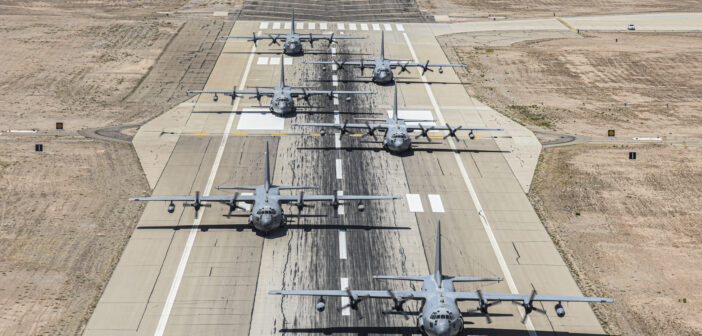BAE Systems (Nashua, New Hampshire) is the mission system prime contractor for the EC-37B Compass Call, serving as the system engineering, integration and testing lead. Says Jared Belinsky, Product Line Director of the Countermeasure & Electromagnetic Attack (CEMA) solutions at BAE, “In addition to our role as the prime mission equipment provider to the Air Force, we also serve as the integrated logistics support lead for the entire EC-37B platform. The transition to the EC-37B is an exciting cross-decking activity that will significantly improve the mission effectiveness of the system, allowing us to continue to disrupt adversary command and control communications capabilities.”
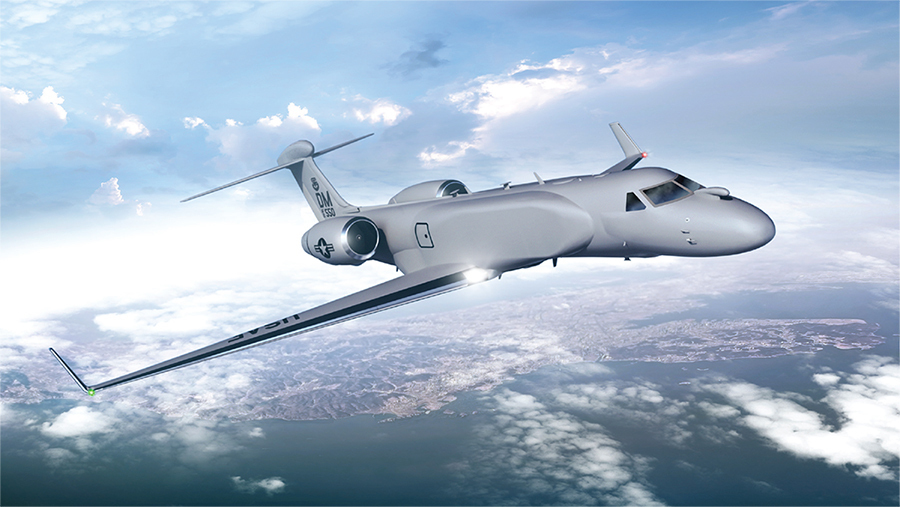
The EC-37B is based on the Gulfstream G550 business jet. BAE Systems
Tom Huerter, Business Development Director for BAE’s CEMA business area, adds that, from his perspective and background as an Electronic Countermeasures Officer flying EA-6Bs, “the operational capabilities that this platform will bring to the fight are truly transformative. It brings Compass Call from the legacy platform that was designed and built for the Cold War fight and puts it into a modern aircraft with an updated system capable of dealing with the threat environment of today, as well as that of the future. The challenge will only continue to grow as we fight to maintain spectrum dominance, but this platform will provide both a major new capability, as well as be highly complementary with the other EA platforms that will be in the DOD inventory, such as the EA-18G Growler. In total, it will have a dominating effect on the battlespace.”
BAE is working together with L3Harris (Melbourne, Florida) the prime platform integration contractor responsible for installing all of the mission electronics, and apertures onto the EC-37B aircraft and delivering it to the Air Force. As of October 2021, L3Harris had carried out roughly a dozen test flights of the first EC-37B Compass Call aircraft at the Gulfstream facility in Savannah, Georgia. These initial tests were to certify the structural changes L3Harris had made to the aircraft to accommodate the full complement of mission equipment it will carry. They included high-altitude (around 40,000 feet) flight and other tests to make sure it could operate effectively in low temperature environments.
MISSION SYSTEM
The Compass Call mission system upgrade effort involves development and implementation of a number of incremental “baseline” capabilities, largely beginning in April of 2021, with BAE Systems’ successful flight testing of its Small Adaptive Bank of Electronic Resources (SABER) technology. The SABER system will transition the Compass Call’s electromagnetic warfare system from a hardware-based to a software-based capability. Built on a suite of software-defined radios using an open system architecture, SABER technology will ultimately facilitate the major software upgrade planned as part of the “Baseline 4” iteration, which is the version being developed for fielding on the next-generation EC-37B Compass Call aircraft.
Says Belinsky, with regard to the overall development and integration of SABER capabilities for the Compass Call mission, BAE wanted to both achieve risk reduction for the EC-37B Baseline 4, but also be able to provide those capabilities to the current EC-130H platform. “Warfighters have a need for those capabilities today, so SABER was our starting point to bring that technology into the program,” he said. As such, there is a Baseline 3 phase of Compass Call that will provide additional interim electronic warfare capabilities for the current EC-130H platform. Baseline 3 is the first step in transitioning the program from the EC-130H to the EC-37B.

Members from the 55th Electronic Combat Group pose in front of their EC-130H Compass Call aircraft during Exercise DEFENDER at Zadar, Croatia, April 2021. USAF
As part of the Baseline 3 work, 11 test flights of the SABER system were flown on EC-130H Compass Call aircraft at Davis Monthan AFB, Arizona. Says Belinksy, “As our first foray into an open-system hardware and software capability for Compass Call, SABER enables the rapid insertion and integration of new technology through software updates instead of hardware reconfiguration. They could be BAE-developed or come from 3rd-party providers, whatever the best available capability is. In May of last year, the Air Force and BAE successfully flight tested three new third-party applications. BAE integrated the applications using its non-proprietary SABER software development kit. The successful flight test will be followed by initial fielding of the capability on the EC-130H.
As explained by Belinsky, the SABER architecture effort was a risk-reduction and proof-of-concept for new capabilities that they’re now incorporating into the EC-37B Baseline 4 architecture. “Using the architecture as a concept that we developed through SABER for the EC-130H, we’re now bringing that architecture forward onto Baseline 4 and the EC-37B in such a way that it extends and provides even more capability than what we were able to post on the EC-130H. We’re really bringing it forward in a much more extensive way, pushing the technology and capability forward and fully exploiting the advantages provided by open architectures in the E3-37B Baseline 4 system.”
In conjunction with this work, in September of last year, BAE delivered “key components” for the US Air Force’s first EC-37B Compass Call aircraft. The components represent the last hardware upgrades planned for Compass Call prior to moving to the much more software-oriented capabilities of the Baseline 4 system. Says Belinsky, “So we’ve now delivered all the electronics, apertures and all of the other equipment that enables the electromagnetic attack mission set to our customer so that it can begin its developmental and operational tests.” The delivery will also support the Air Force’s developmental and operational flight testing of the Baseline 3 configuration of Compass Call on EC-130H aircraft expected to begin in January 2023. “So,” says Belinsky, “as of today for the EC-37B Baseline 3, we’ve delivered our prime mission equipment to aircraft number one to L3 Harris in Waco, Texas, so that they can incorporate it onto that first aircraft and deliver it to the Air Force, which is a process they’re currently undergoing. Once they’ve done this, the Air Force will begin developmental and operational test of the new EC-37B which is planned for 2023.”
Summing up the overall effort, Huerter explains that, “The current version of Compass Call that is on the EC-130Hs today is what we call the mid-Baseline 2. The interim Baseline 3 Compass Call architecture version is for the first five EC-37B aircraft. The second five aircraft will be the Baseline 4 system architecture capability. So, we’re taking the opportunity to prove out the SABER technology and field it now on the EC-130H (as what we call a clip-in) which has been the way that added capability has been brought to that platform for forty years. SABER is foundational as we redesign the software and some of the hardware architecture for Baseline 4 but, though SABER is a great new capability and significant move forward, it’s still just a kind of baby step to what becomes a broader capability and truly a rapid insertion environment with Baseline 4.”
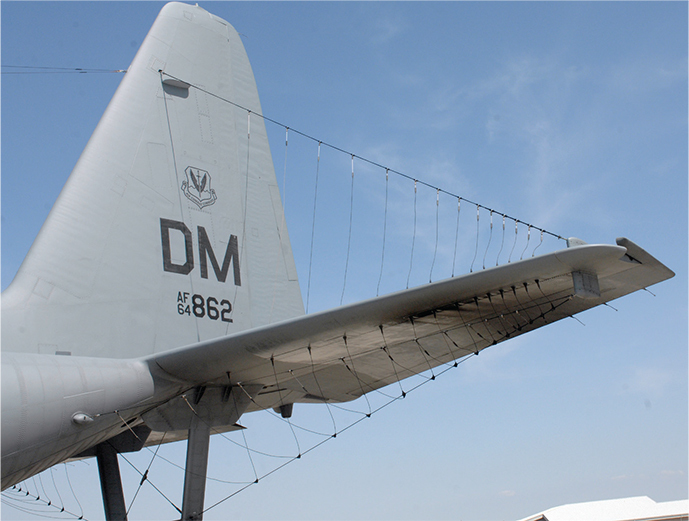
GETTING SMALL
Clearly, one of the biggest challenges in cross-decking Compass Call from the EC-130H to the much smaller EC-37B platform was reducing the size of the system and its on-aircraft support requirements. Given that the current platform is itself packed full of equipment, this was a substantial undertaking. But, says Belinsky, “The new, modern technology available to us today is what makes this possible. As we work towards and develop an open-system hardware and software solution for the EC-37B, we’re able to reduce the size, weight and power (SWAP) requirements of the prime mission equipment.” In addition, he notes that the current cooling requirement for the system electronics is also dramatically reduced with modern technology. “For the amount of processing power the system has, it doesn’t require nearly the amount of cooling, and we can take advantage of that as well.”
Still, says Huerter, “Our engineers overcame some great challenges in taking about 18-19,000 lbs. of mission equipment and squeezing it down to about 8,000 lbs.” Despite its smaller size compared with the EC-130H, Huerter points out that the Gulfstream G-550 conformal AEW aircraft was actually ideal for the cross-deck effort. “First of all, the weight capacity gave us more than what we needed, and the power and cooling available on the platform was perfect for what we needed. And, especially those large array panels on the ‘cheek’ gave us all the area that we needed to incorporate the arrays. It’s really an ideal fit for us.”
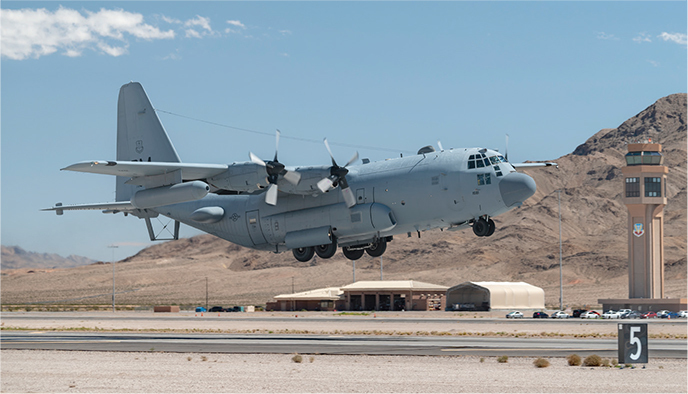 USAF
USAF55th ELECTRONIC COMBAT GROUP
As with the Air Force’s EC-130H Compass Call aircraft, the new EC-37B-hosted system will be flown and operated by the 55th Electronic Combat Group (ECG) at Davis-Monthan, AFB. Under the command of Col Melanie Olson, the 55th ECG is responsible for the five squadrons that provide combat ready EC-130H Compass Call aircraft, aircrew and maintainers for worldwide expeditionary deployments in support of unified combatant commanders.
Huerter says they are working very closely with the 55th ECG on the program. “The partnership between industry, Government, the Air Force and ‘Big Safari’ [program office]and the 55th ECG is more than I’ve seen before. As we provide the contract logistics support on the maintenance side, we’re also developing the crew mission system simulator, which we’re building for outfitting at Davis-Monthan, and helping them put together their training syllabi both there and with the Air Force Weapons School at Nellis AFB, Nevada, to help with the transition of their aircrew and maintenance teams over to the new platform.”
In addition, Huerter says they’re spending considerable time and effort to not only reduce the operator workload but significantly enhance mission effectiveness. “By optimizing the operator experience through various automated decision aids and improved Human to Machine Interface (HMI) tools, the EC-37B EWOs will have better situational awareness and more real time targeting capability than their EC-130H predecessors.”
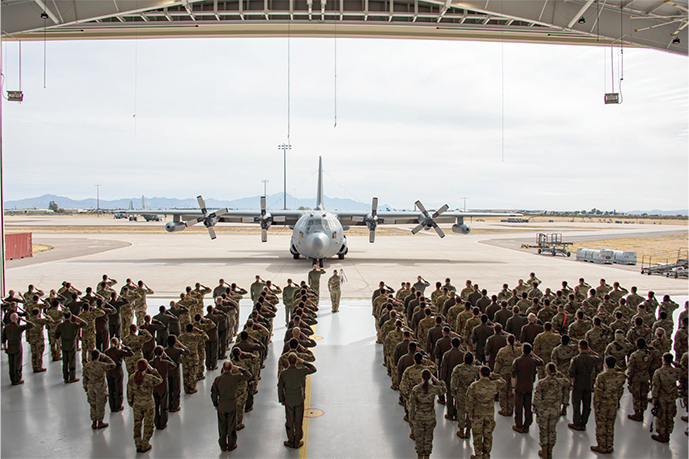
KEEPING PACE WITH THE THREAT
As emphasized by BAE’s Belinski, “To meet the mission requirements of Compass Call, we’ve needed to be highly focused on, and up to date on our adversaries’ command, control and communications systems as well as their air defense radars, data links and navigation systems. And so, we’ve strived throughout the life of this program, together with the Air Force, to keep pace with the emerging threats and to evolve the system along the way to continue to be relevant into the future.”
In that regard, Huerter references the presentation by Chris O’Donnell, Deputy Assistant Secretary of Defense, Platform and Weapon Portfolio Management, at the 2022 AOC National Symposium, where he emphasized the importance of the Counter-C5ISRT mission and meeting its requirements. “Our adversaries are not waiting for us,” O’Donnell told the audience. “Across all domains, they’re constantly seeking to out-compete and out-innovate us. Considering our strategic competitors have advanced layered and integrated sensing and electromagnetic warfare capabilities, now more than ever, the US needs to maintain superiority across the spectrum.”
As part of its work aimed at maintaining spectrum superiority, O’Donnell pointed to the DOD’s creation of Integrated Acquisition Portfolio Reviews (IPRs) to strengthen the synchronization of warfighting concepts, requirements, technologies and program execution across DOD – one of which was the Counter-C5ISRT IPR. “With the completion of the Counter-C5ISRT IPR, we were able to show the Department what EW can do in order to address one of the most critical problems we currently face in a peer-to-peer competition.”
O’Donnell further called out the need for “…targeted investments and innovative and novel capabilities, such as cognitive EW to counter advanced and non-traditional threats to break an adversary’s kill web, with an emphasis on Counter-C5ISRT, or left-of-launch capabilities.” He added, “A number of enabling technologies will allow us to keep pace with the evolving threat and to operate in a complex electromagnetic environment.” And, in that regard, says Huerter, “That is the sweet spot for the E3-37B Compass Call, and that is what we’re delivering to the modern battle space.”

